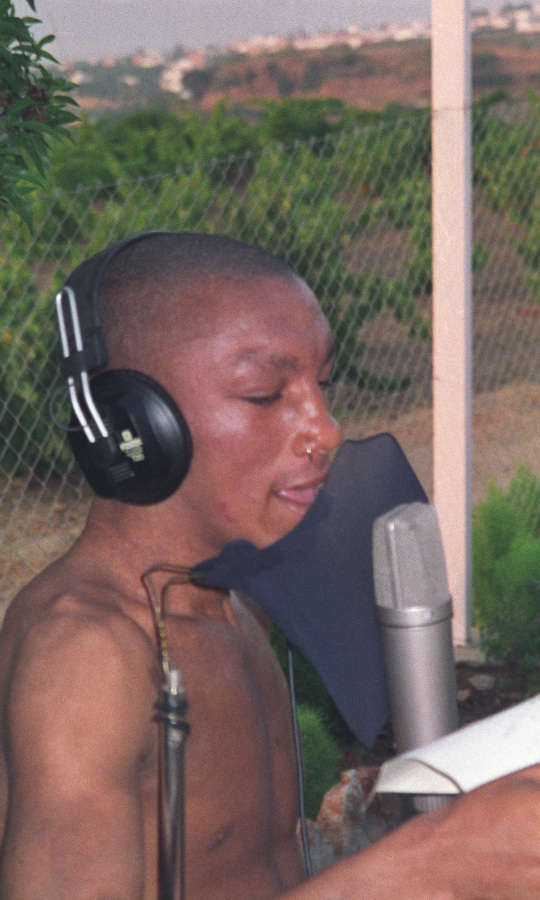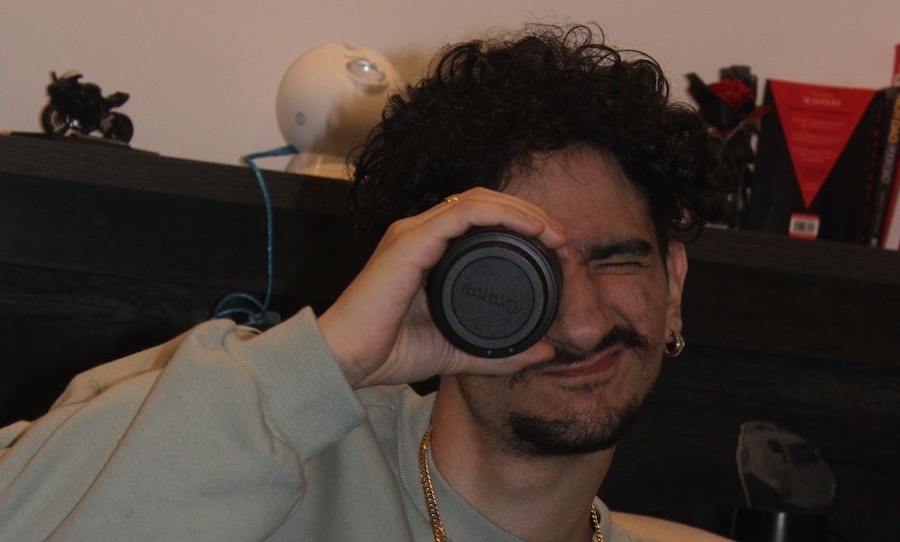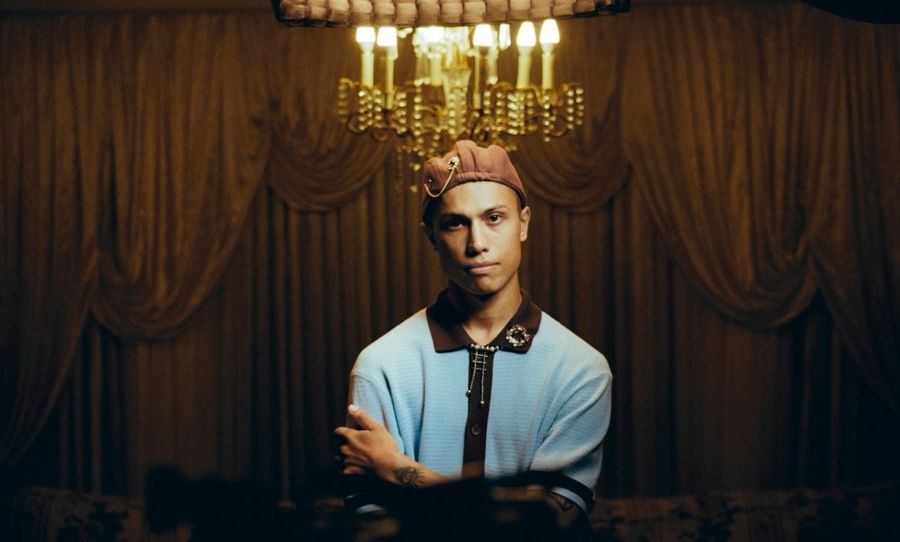ARLS is a collaboration between singer/songwriter Alba Rose, and composer and producer, Bravo Bonez. Alba is based in New Zealand, whereas Bravo splits his time between London and Wellington, NZ. They decided to put together ARLS after a chance meeting in mid-2018.
Having recently released their debut trip-hop inspired track LUCKY, ARLS are releasing a debut EP MELD in early 2020. The EP is a celebration of 1990s genres, including trip hop, acid jazz and electro pop. ARLS have managed to secure the talents of one of the great UK producers Mark Saunders for a trip-hop style remix of their next single PACE. The track is to be released in the coming months. Mark co-produced what many believe to be the greatest trip hop album of all time, Tricky’s Maxinquaye. Alba and Bravo asked Mark a few questions ahead of working with him.

The highly talented trip-hop duo ARLS have caught up with prominent UK producer Mark Saunders for an inside scoop on the music industry.
ARLS: Hi Mark. Thanks for chatting with us.
MARK: Pleasure!
ARLS: Let’s leap into it. Tell us about which other artists you have worked with?
MARK: I’ve been extremely lucky to have worked with some excellent bands/artist including The Cure, Neneh Cherry, David Byrne, Marilyn Manson, Lisa Stansfield, David Bowie, Mick Jagger, Ian McCulloch, Siouxsie And The Banshees, Erasure, Pnau and Cyndi Lauper.
ARLS: Which singles and/or albums are you most proud of?
MARK: Buffalo Stance by Neneh Cherry would have to be the single I’m most proud of – and it also happens to be one of the most most pleasant experiences of my career. Working with Tim Simenon (Bomb The Bass) taught me a lot. We co-produced the the song and Tim was a young DJ, fairly new to production and did not have the recording studio background that most regular producers had. I had already been working for a couple of years in studios and was used to working crazily long hours and slaving over the minutiae of a track. Tim’s approach was different – he wanted to keep things simple and be out of the studio at 6pm because he had more fun things to do! As a result, the song wasn’t worked to death and sounded pretty fresh and unique when it came out. Buffalo Stance was my first production gig and also the first track that I programmed drums and keyboards for. I had a little Casio CZ101 as my master keyboard and an Akai S900 sampler. As I was programming the track, Tim had a turntable hooked up to the mixing desk and when he came up with cool bits and pieces, I sampled them into the Akai so we could move them around within the track, Neneh was brilliant to work with. Her vocal takes were fantastic and inspired. They were laden with extra ad libs and had tons of character. We recorded her vocals on the second day, when, in my opinion, the track was just a rough sketch of what it could be. But after the vocals were finished Tim basically said ‘right that’s it then, we’re finished!’. The only thing that was added afterwards I believe was the riff played on an Emulator guitar sample. I came up with the riff whilst playing a guitar along with the track in the live room whilst everyone else was listening back to the vocals in the control room. I thought everyone else would think it was uncool so I recorded it after everyone else had left the studio. At the mix, I only played it to Tim after the rest of the mix was complete. I was sure he wouldn’t like it – but he did. And, years later, apparently so did celebrity chef, Jamie Oliver, because someone told me he often used the instrumental part of Buffalo Stance with that riff in it as background music on his shows! The whole track was recorded and mixed in two and a half days which was pretty quick. I wasn’t convinced though that it was actually finished until I heard it on the radio. Then I realised that we hadn’t needed to overthink the track because Neneh sounded so amazing. It was all about her performance. I was lucky enough to be with Neneh when she was asked for her first autograph just off of Kensington High St. We were on our way to the studio to work on the rest of her debut album, Raw Like Sushi, when a Fedex truck jammed on it’s brakes alongside us and the driver jumped out and said ‘Are you Neneh Cherry?!
ARLS: Tell us about working on Maxinquaye with Tricky.
MARK: Maxinquaye was a huge un-learning experience for me! My prior knowledge of how to make a record went right out of the window. I liken the project to building a car from parts at a scrapyard. We put things together that somehow don’t normally fit but somehow managed to build a car – not a necessarily pleasing to the eye car, but one that ran, albeit a pretty roughly. Tricky failed to show up twice for an initial meeting with me at Island Records, so in the end I went to his house to meet him. He was not what I expected at all – he was pretty hyper and very enthusiastic to meet me – he told me that he loved The Cure and that was a big part of the reason he wanted to work with me. I found that bizarre considering the two tracks that Tricky had already finished with Howie B, (Ponderosa and Aftermath) were a million miles in the opposite direction to the The Cure! But I quickly came to realise that Tricky had a very varied musical taste. Most of his music was on vinyl – and most of that was scattered all over the floors of his flat. You literally had to walk on vinyl to get around. The first day we started work, we recorded Sufferin. We were in his Kensal Rise flat with a minimal amount of gear – an Atari 1040st computer running Cubase, an Adat tape machine and an Akai S900 or S1000 sampler. We had a £200 AKG mic and we were running it all through a little Mackie board. Initially my role was to be engineer because the label was under the illusion that Tricky was a programmer/beats/producer kind of guy. He even persuaded them to put this little studio in his flat. But on that first day Tricky announced to me ‘I don’t know how to use any of this stuff!’. So on that first day Tricky plucked a couple of records off the floor and said he wanted to sample bits of them and make a track out of them. Logically, I listened to them and said, ’that’s not going to work because they are different tempos and in different keys’. Bear in mind that technology wasn’t as great as it is now and manipulating audio was much more limited then. Anyway Tricky said he wanted to hear it so I sampled the sections he wanted to use from both records whilst thinking ‘this is a complete waste of time’ and ‘this guy’s nuts!’. Once in the sampler I tried playing the two bits together and predictably it sounded like a massive train wreck – meanwhile Tricky sat listening with a spliff, nodding to some beat that didn’t exist and declared it to be ‘wicked!’ I was pacing around behind him contemplating my exit from this weird gig before I went insane. However, I started messing around detuning one sample against the other and adjusting the lengths of the samples etc and after a few minutes of absolute cacophony, a magic totally unpredictable combo of the two samples emerged. All of a sudden there was this slow, earthy, gritty beat – at which point Tricky piped up with ‘See! I told you it was wicked!!’ This was pretty much how all the tracks started out! During that first day, a guy knocked on the door and said he was in the flat downstairs. He was remarkably not pissed off as he asked us if we could turn the bass down a bit. He said ‘I don’t really mind, but I’m trying to eat my dinner and the bass is making my plate move across the table – it’s hard to eat!’. The first time we recorded vocals there, I was blown away by Martina’s vocals. She was in a relationship with Tricky which was tricky to say the least and this was a big part of how the album ended up sounding. She was young, but to me she seemed like an old tortured (not literally!) soul. She seemed to have no energy and shuffled around around the flat in slow motion almost. Yet when Tricky scribbled out some words and told her to go into the kitchen (where the mic was setup) to sing, total magic happened. Most of the time Martina’s wasn’t around when Tricky and I were making the tracks, she was called in at the vocal stage. She never listened to the track first whilst looking at the lyrics and try to work out what she was going to sing, she just took the lyrics, shuffled into the kitchen, I’d play the track and she start singing the words. The first time this happened, with ’Strugglin’, the hair stood up on the back of my neck. She sung the most beautifully delicate, fragile sounding melodies imaginable. She sang through the song twice and I used her totally unedited first vocal as the lead and her second one as a double track/backing vocal. And that was how she was on all the songs that I worked on with her. She was totally brilliant – and also the quietest singer I’d ever recorded. I had to turn the mic gain up tons to capture her. One day she coughed or sneezed and it nearly blew my head off! At the end of the first day, the Island records A&R man came by to check on us. Tricky made him smoke a spliff and then shut him in our ‘control room’ with the lights off and made him listen to Strugglin. He came out a few minutes later looking totally freaked out – but excited about what we were doing. The mix on the album of Strugglin is off a cassette that we made right after we finished recording it. There was no mix session. That night, I went home and called my manager and told her that my role was a lot more than just engineer, so I ended up with a co-production credit. In hindsight, I should have pushed for a publishing credit! In typical big label fashion, after the record was finished and I was being told by Island that I’d just made what they predicted (correctly) would a critically acclaimed record, Island’s business department told my manager that Dave Gilmour wasn’t senior enough to negotiate my co-production credit and extra money and said they weren’t going top honour it. It took my manager sixth months to fight that one and win. Charming!
ARLS: What is the strangest experience you had as a mix engineer or producer?
MARK: Where to start?! It would be easier to think of projects that weren’t strange or bizarre! Maxinquaye has to be up there as one of the strangest experiences though. But there are so many others – like the time I was an assistant engineer on an Asia album and we thought the bass player/singer, John Whetton, had died on us. He was napping on the sofa in the control room and when it was time for him to sing a vocal, no one could wake him up. It seemed like an eternity of people shaking him, slapping him, shouting at him before he finally spluttered back to life again! Another time I had the misfortune to be an assistant on a Dexy’s Midnight Runners album for a few weeks. Singer/dictator Kevin Rowland seemed to have it in his head to make this the most torturous and expensive album in history to produce. He would rent expensive vintage Hammond organs and Fender Strats and just keep them for weeks/months even if no one was using them. The label stopped paying the bills after they’d shelled out something like £600,000 and Kevin started wasting his own money. The guitar player, Billy, had – shall we say – an unusual style of playing. He didn’t strum chords like normal humans and his playing involved breaking an ungodly amount strings. He could break two or three strings within the recording of one verse of a song!. If this wasn’t frustrating enough, when it came to tuning the guitar up again after the new string was on, Kevin had his own theories about tuning. Firstly, it had to be a democratic process involving the whole band. Kevin would summon the whole band to join him and Billy around the piano – for in Kevin’s mind, certain strings hard to be tuned to a guitar tuner, others to a piano and the rest to a pitch fork. This process could take 20 mins or more by the time everyone had agreed that the guitar was indeed in tune. Then Billy would proudly walk back into the control room with his newly tuned guitar, play a few more bars before – ‘ping!’, another string would break. The producer and I would put our heads in our hands and feel like weeping with despair.
ARLS: What makes a great trip-hop track?
MARK: Don’t know to be honest! When I worked with Tricky, the genre didn’t exist yet. We didn’t know we were making a trip-hop label. I didn’t know what we were making to be honest, I wasn’t convinced that anyone would even like what we were creating! I come from a total pop background. I love pop music. I was the weirdest choice to pair up with Tricky really. I fought to make Maxinquaye as musical as possible. Tricky would come in to the studio and would have a burst of energy for about three hours, we’d create a track, get Martina in to sing it and then Tricky would tell me he was exhausted and go home. I would then work on arranging the track, adding musical elements that I hoped I could get away with when Tricky heard it the next day. In fact I quickly realised that if he wasn’t in the room when I was trying to do any of this stuff, I was more likely to get away with it. Left to his own devices Tricky would have been happy to have just one drum loop, a bass and vocal on most tracks. For instance, with ‘Black Steel’ the first 42 seconds of the final version is how it was all the way through. That was until Tricky got drunk at a gig one night and invited a support band to come and play on his album. He had no memory of this the next day until his manager phoned and said she’d had a call from the band from up north who wanted to sort out the logistics! Tricky had no memory of what they sounded like and this was the days before music being on line so until they showed up, we were in the dark. They turned out to be a kinda of live instruments techno band. I got them to play more like a punk bad though on Black Steel because it was the most sparse track we had at that time. I loved it. Tricky said ‘I’m not going to use any of this’ as the band were saying their goodbyes. Fortunately, I don’t think they heard it. By that point in the album I knew it wasn’t a good idea to argue, I just worked on the track on my own for a bit and had it playing one day as Tricky walked in the studio. He said ‘what’s that?’ in his brilliant Bristolian accent, ‘that’s wicked!!’
ARLS: How do you think data, new home software, and technology are changing the music industry?
MARK: Absolutely. Mind bogglingly so! Not always to the benefit of those that use it. It’s too easy to keep adding tracks and tracks of parts to songs now. I think in the days of tape, the restriction of 4, 8, 16, or 24 track tapes made people think about how important a particular new idea was. Now people send songs for me to mix with massive amounts of parts on them and it takes ages to listen through to them all and decide what is really needed and what is not.
ARLS: Do you think there is more pressure for artists these days to make a ‘hit’ due to the increased use of platforms, like Spotify playlists?
MARK: I think the days of saying ‘it’s only an album track’ are over. Not much point in releasing a half inspired tune on Spotify – no one’s every going to play it twice because there are so many good songs out there to choose from. I suppose the rise in vinyl sales counteracts this a bit though. Artists/bands definitely have to up their game if they want people to listen to a whole album.
ARLS: We are happy with the current mix of PACE, our single to be released in early 2020. But we always keep an open mind. We are fascinated by what you might bring to the planned trip hop remix you are doing for us. What might we expect?
MARK: I would like to strip it back a bit and make it more moody. I think I would slow it – not the actual tempo, but the feel of of it. A less driving drum beat would be my first move. I’d listen to it without the fast sequencer lines too and see how it feels then. I think the vocal will lend itself to a more sparse, moodier mix. But then again, sometimes when you get stuck into a remix, something triggers you into a completely different direction than you originally thought you’d go in.
ARLS: If you had any advice for current musicians developing tracks themselves, what might that be?
MARK: See how few elements you can get away with to support the song. If you keep adding shit and the song is still not working, then take it all off and try rethinking the song….treat if like a remix and see where it goes. Change the chords underneath the existing vocal. You never know!
ARLS: What is the best piece of advice you were ever given?
MARK: I think that would be when I was a drummer in a band in the early Eighties and we went into a studio for the first time with a producer to do a demo. We were working on the first song and the producer told me to play less. I was very resistant to the idea at first but when I listened back to the stripped out parts, it sounded way better. “Less is more’ – always!
ARLS: Thanks so much for your time on this interview Mark. Such an interesting career! Can’t wait to hear your work on our track!
MARK: Looking forward to it!

Caption: A photo taken by Mark Saunders of Tricky when recording vocals outside in Spain immediately after finishing Maxinquaye while working with Neneh Cherry.




